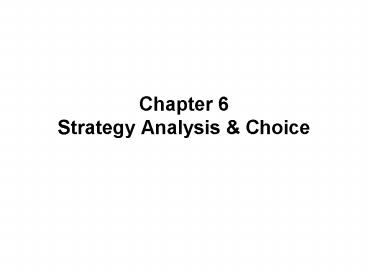Chapter 6 Strategy Analysis PowerPoint PPT Presentation
1 / 26
Title: Chapter 6 Strategy Analysis
1
Chapter 6Strategy Analysis Choice
2
Strategy Analysis Choice
Nature of Strategy Analysis Choice
- -- Establishing long-term objectives
- -- Generating alternative strategies
- -- Selecting best alternative to achieve
mission objectives
3
Comprehensive Strategy-Formulation Framework
Stage 1The Input Stage
Stage 2The Matching Stage
Stage 3The Decision Stage
4
Strategy-Formulation Analytical Framework
Internal Factor EvaluationMatrix (IFE)
Stage 1The Input Stage
External Factor EvaluationMatrix (EFE)
5
Stage 1 The Input Stage
- Basic input information comes from the internal
/external evaluation (matrices) - Requires strategists to quantify subjectivity
early in the process the assigned weights - Good intuitive judgment always needed
6
Strategy-Formulation Analytical Framework
SWOT Matrix
Stage 2The Matching Stage
BCG Matrix
7
Stage 2 The Matching Stage SWOT analysis
- Match between organizations internal strengths
and weaknesses and the opportunities risks
created by its external factors - E.g. internal strong R and D function
- External changing demographics (e.g. population
getting older) - Strategy Develop new products for older adults
(related to long term objectives financial or
strategic)
8
Stage 2 The Matching Stage SWOT Matrix
Four Types of Strategies Strengths-Opportunities
(SO) Use a firms internal strengths to take
advantage of external opportunities
Weaknesses-Opportunities (WO) Improving
internal weaknesses by taking advantageof
external opportunities Strengths-Threats
(ST) Use a firms strengths to avoid or reduce
the impact of external threats. Weaknesses-Threat
s (WT) Defensive tactics aimed at reducing
internal weaknesses and avoiding external threats
9
Matching Key Factors to Formulate Alternative
Strategies
Key Internal Factor
Key External Factor
Resultant Strategy
Which types of strategies, e.g. intensive
diversification, are referred to above
10
Ryanair Matching Key Factors to Formulate
Alternative Strategies
Key Internal Factor
Key External Factor
Resultant Strategy
The above is based on the internal and external
evaluation of Ryanair
11
Limitations with SWOT Matrix
- Does not show how to achieve a competitive
advantage - Provides a static assessment in time
- May lead the firm to overemphasize a single
internal or external factor in formulating
strategies
12
Boston Consulting Group (BCG) Matrix
- Enhances multi-divisional firm in formulating
strategies - Divisions may compete in different industries
- Focus on market-share position industry growth
rate
13
BCG Matrix
Relative Market Share Position
High 1.0
Medium .50
Low 0.0
Industry Sales Growth Rate
High 20
Medium 0
Low -20
- Ratio of a divisions own market share in an
industry to the market share held by the largest
rival firm in that industry
14
BCG Matrix
Quadrant 1 Question Marks or Problem child
- Low relative market share compete in
high-growth industry - Cash needs are high
- Case generation is low
- Decision to strengthen (intensive strategies) or
divest (a defensive strategy)
15
BCG Matrix
Stars
- High relative market share and high growth rate
- Best long-run opportunities for growth
profitability - Substantial investment to maintain or strengthen
dominant position - Integration strategies, intensive strategies
16
BCG Matrix
Cash Cows
- High relative market share, competes in
low-growth industry - Generate cash in excess of their needs
- Milked for other purposes
- Maintain strong position as long as possible
- Product development, Related diversification
- If weakensretrenchment or divestiture
17
BCG Matrix
Dogs
- Low relative market share compete in slow or no
market growth - Weak internal external position
- Liquidation, divestiture, retrenchment
18
Strategy-Formulation Analytical Framework
Quantitative StrategicPlanning Matrix(QSPM)
Stage 3The Decision Stage
- Technique designed to determine the relative
attractiveness of feasible alternative actions
19
Steps to Develop a QSPM
- Make a list of the firms key external
opportunities/threats and internal
strengths/weaknesses in the left column - Assign weights to each key external and internal
factor - Examine the Stage 2 (matching) matrices, and
identify alternative strategies that the
organization should consider implementing - Determine the Attractiveness Scores (A.S)
- Compare the Total Attractiveness Scores
- Compute the Sum Total Attractiveness Score
20
QSPM information from IFE and EFE
Strategic Alternatives
AS 1 to 4 and blank if factor does not effect
strategy TAS Weight x AS
21
Ryanair Sample QSPM matrix
22
Ryanair Sample QSPM matrix
23
Ryanair Sample QSPM matrix
24
Ryanair Sample QSPM matrix
Recommendations Invest 100 million in
terminal space annually at new airports not
currently serviced. What is this type of
generic strategy does it correspond to the
proposed strategies of the grand strategy and BCG
matrix
25
QSPM
Limitations
- Requires intuitive judgments educated
assumptions - Only as good as the prerequisite inputs
Advantages
- Sets of strategies considered simultaneously or
sequentially - Integration of pertinent external internal
factors in the decision making process
Example of a QSPM for Dell
26
Questions
- Explain, using suitable examples, how you would
use a SWOT analysis in strategic formulation.
(10 marks). - What are the main limitation associated with
using this analysis (2 marks) - Describe, the relationship between the quadrants
of the BCG matrix and the growth of an industry
and the organisations market share. (8
marks) - Explain, using an example, the types of
strategies a firm could adopt in any three of
these quadrants. (10 marks) - How would you choose the most appropriate
strategy given you have performed an internal and
external evaluation. (10 marks)

